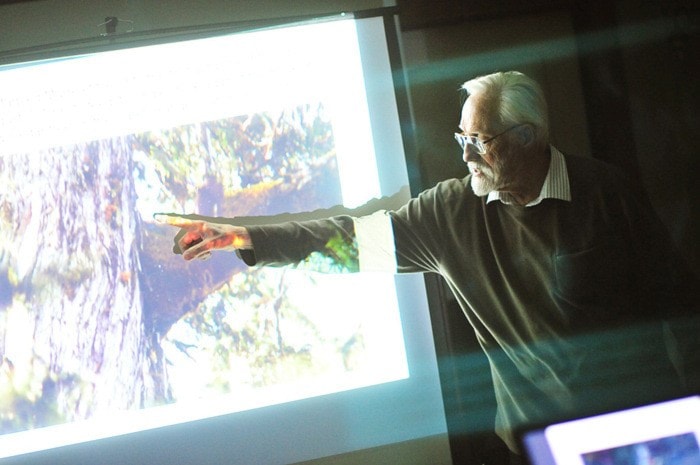Delta Naturalists recently learned how the discovery of one bird’s nest, hidden two-thirds of the way up a 120-foot yellow cedar tree, helped turn a forest threatened with imminent logging into a provincial park.
Environmentalist and author Paul Jones was the man responsible.
In 1991, he set out on an expedition to the Caren Range, an area of thick, ancient forest on the Sunshine Coast, looking for evidence of nesting sites of the marbled murrelet.
Jones and his small team became familiar with the threatened auk-like bird’s high-pitched call, and certainly saw a few flying around or fishing, but it would take two years of before they found the first active nest in Canada.
Speaking to a group of Delta Naturalists Society (DNS) bird enthusiasts at a recent monthly meeting, he described Aug. 7, 1993 as “quite a morning” – and in terms of saving the untouched wilderness from loggers, the 11th hour.
The finding was so important, he felt it necessary to keep the location a secret from authorities while his team documented the growth of the lone chick in the nest.
Over the next several years, Jones took notes, sketched and photographed the nest’s activity.
 Photo: A sketch of marbled murrelets by Paul Jones.
Photo: A sketch of marbled murrelets by Paul Jones.
He learned that the single egg was incubated for exactly one month; that the chick was fed up to eight times a day, with both parents sharing feeding duties; and that the marbled murrelet had a symbiotic relationship with the Bonaparte gull – gulls spotted schools of fish in the water while diving murrelets pushed them to the surface, where both bird species feasted.
The discovery of a second nest in 1997, plus the observation that both nests sat in trees about 1,500 years old, was enough to have the provincial government reserve 2,979 hectares of forest as Spipiyus Provincial Park on June 29, 1999.
Jones’ narrative, if esoteric for the general population, fit like a glove for his audience at Cammidge House in Boundary Bay Regional Park.
Society president Tom Bearss, a former diplomat, calls the heritage building a Mecca for birders.
“We’ve got 80 some-odd members now.”
Each month, the group has guest speakers who cover a variety of topics on birds, travels or environmental issues – usually illustrated.
Every week, Bearss also leads the Delta Nats Casual Birders, a sub-species of DNS, on bird watching hikes in the area.
Outings regularly include places such as Boundary Bay Regional Park, Reifel Migratory Bird Sanctuary, Roberts Bank, the Serpentine Wildlife Management Area, Point Roberts, Burns Bog and Deas Island Regional Park.
The Society, composed of a mix of birdwatchers, photographers and environmentalists, formed in the mid-1980s.
Its activities include displays at community events, nest box construction and stewardship and nature consultation on community issues – the group was active in convincing The Corporation of Delta to ban cosmetic use of pesticides two years ago.
The Delta Naturalists Society meets on the second Monday of each month (except July and August) at 7:30 p.m. at Cammidge House in Boundary Bay Regional Park. Membership fees are $30 per person and $40 per family. Delta Nats Casual Birding goes for walks once a week (Mondays or Wednesdays.) For more information, visit http://dncb.wordpress.com/ or contact Tom Bearss at 604-940-9296 or tom.bearss@dccnet.com
bjoseph@surreyleader.com
